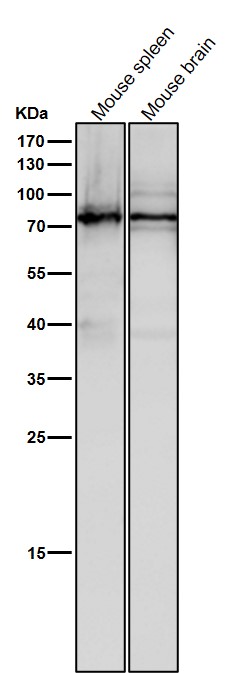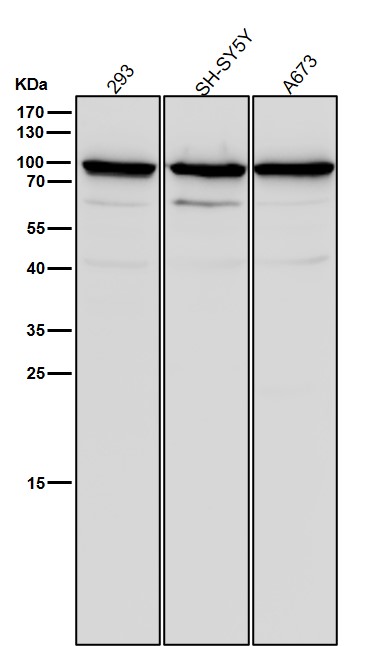


| WB | 咨询技术 | Human,Mouse,Rat |
| IF | 咨询技术 | Human,Mouse,Rat |
| IHC | 1/100-1/200 | Human,Mouse,Rat |
| ICC | 技术咨询 | Human,Mouse,Rat |
| FCM | 咨询技术 | Human,Mouse,Rat |
| Elisa | 咨询技术 | Human,Mouse,Rat |
| Aliases | Adseverin; Scin; Scinderin;;Scinderin |
| WB Predicted band size | 80 kDa |
| Host/Isotype | Rabbit IgG |
| Antibody Type | Primary antibody |
| Storage | Store at 4°C short term. Aliquot and store at -20°C long term. Avoid freeze/thaw cycles. |
| Species Reactivity | Human,Mouse,Rat |
| Immunogen | A synthesized peptide derived from human Scinderin |
| Formulation | Purified antibody in PBS with 0.05% sodium azide,0.05% BSA and 50% glycerol. |
+ +
以下是关于SCIN(Staphylococcal Complement Inhibitor)抗体的3篇参考文献,涵盖其结构、功能及治疗应用:
---
1. **文献名称**:*Structural basis for complement inhibition by Staphylococcus aureus*
**作者**:Rooijakkers, S. H., Ruyken, M., Roos, A., et al.
**摘要**:本研究解析了SCIN蛋白通过结合补体C3转化酶(C3bBb)抑制补体活化的分子机制,揭示了其阻断免疫清除、帮助金黄色葡萄球菌逃逸宿主防御的结构基础。
---
2. **文献名称**:*Neutralizing anti-SCIN antibodies restore phagocytic clearance of Staphylococcus aureus*
**作者**:Sharp, J. A., Whaley, R. C., Tran, M. T., et al.
**摘要**:开发了靶向SCIN的中和抗体,实验证明其能逆转SCIN对补体介导的调理作用,增强巨噬细胞对细菌的吞噬,为抗感染治疗提供了新策略。
---
3. **文献名称**:*Targeting SCIN with monoclonal antibodies limits Staphylococcus aureus dissemination in vivo*
**作者**:Laursen, N. S., Mazar, J., Kristensen, P., et al.
**摘要**:通过体外和动物模型验证了抗SCIN单克隆抗体抑制细菌免疫逃逸的能力,表明其可降低感染严重程度,为临床抗体疗法开发奠定基础。
---
这些研究聚焦于SCIN的免疫抑制机制及抗体干预的潜在应用,为抗金黄色葡萄球菌感染提供了理论和技术支持。
SCIN (Staphylococcal Complement Inhibitor) is a secretory protein produced by *Staphylococcus aureus*, a pathogenic bacterium associated with diverse infections. Discovered in the early 2000s, SCIN plays a critical role in immune evasion by targeting the human complement system. It specifically binds to and stabilizes C3 convertase (C3bBb), a key enzyme in the complement cascade, thereby blocking its enzymatic activity. This inhibition prevents opsonization, phagocytosis, and membrane attack complex (MAC) formation, allowing *S. aureus* to evade host immune defenses.
Structurally, SCIN is a small, 9.8 kDa protein with a compact β-sandwich fold. Its interaction with C3 convertase involves binding to both C3b and Bb subunits, inducing conformational changes that render the enzyme inactive. SCIN antibodies, typically generated in laboratory settings (e.g., polyclonal or monoclonal), are essential tools for studying bacterial immune evasion mechanisms. They enable detection of SCIN in experimental models, facilitate structural analyses, and help evaluate its role in infection pathogenesis. Additionally, SCIN-neutralizing antibodies are explored for therapeutic potential, aiming to restore complement-mediated clearance of *S. aureus*. Research on SCIN and its antibodies continues to advance understanding of host-pathogen interactions and antimicrobial strategies.
×